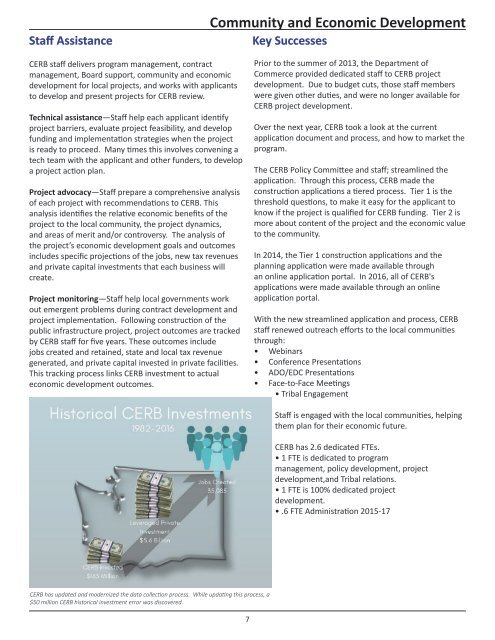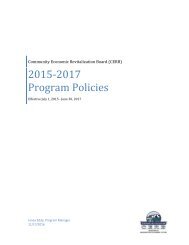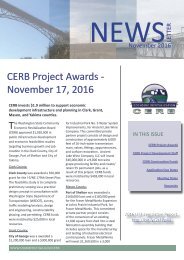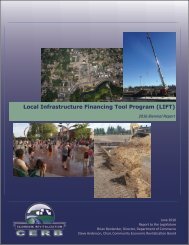2016 CERB Legislative Report
The Community Economic Revitalization Board (CERB) was formed in 1982 to respond to local economic development in Washington communities. CERB provides funding to local governments and federally-recognized tribes for public infrastructure which supports private business growth and expansion. Eligible projects include domestic and industrial water, storm water, wastewater, public buildings, telecommunications, and port facilities.
The Community Economic Revitalization Board (CERB) was formed in 1982 to respond to local economic development in Washington communities. CERB provides funding to local governments and federally-recognized tribes for public infrastructure which supports private business growth and expansion. Eligible projects include domestic and industrial water, storm water, wastewater, public buildings, telecommunications, and port facilities.
You also want an ePaper? Increase the reach of your titles
YUMPU automatically turns print PDFs into web optimized ePapers that Google loves.
Staff Assistance<br />
Community and Economic Development<br />
Key Successes<br />
<strong>CERB</strong> staff delivers program management, contract<br />
management, Board support, community and economic<br />
development for local projects, and works with applicants<br />
to develop and present projects for <strong>CERB</strong> review.<br />
Technical assistance—Staff help each applicant identify<br />
project barriers, evaluate project feasibility, and develop<br />
funding and implementation strategies when the project<br />
is ready to proceed. Many times this involves convening a<br />
tech team with the applicant and other funders, to develop<br />
a project action plan.<br />
Project advocacy—Staff prepare a comprehensive analysis<br />
of each project with recommendations to <strong>CERB</strong>. This<br />
analysis identifies the relative economic benefits of the<br />
project to the local community, the project dynamics,<br />
and areas of merit and/or controversy. The analysis of<br />
the project’s economic development goals and outcomes<br />
includes specific projections of the jobs, new tax revenues<br />
and private capital investments that each business will<br />
create.<br />
Project monitoring—Staff help local governments work<br />
out emergent problems during contract development and<br />
project implementation. Following construction of the<br />
public infrastructure project, project outcomes are tracked<br />
by <strong>CERB</strong> staff for five years. These outcomes include<br />
jobs created and retained, state and local tax revenue<br />
generated, and private capital invested in private facilities.<br />
This tracking process links <strong>CERB</strong> investment to actual<br />
economic development outcomes.<br />
Prior to the summer of 2013, the Department of<br />
Commerce provided dedicated staff to <strong>CERB</strong> project<br />
development. Due to budget cuts, those staff members<br />
were given other duties, and were no longer available for<br />
<strong>CERB</strong> project development.<br />
Over the next year, <strong>CERB</strong> took a look at the current<br />
application document and process, and how to market the<br />
program.<br />
The <strong>CERB</strong> Policy Committee and staff; streamlined the<br />
application. Through this process, <strong>CERB</strong> made the<br />
construction applications a tiered process. Tier 1 is the<br />
threshold questions, to make it easy for the applicant to<br />
know if the project is qualified for <strong>CERB</strong> funding. Tier 2 is<br />
more about content of the project and the economic value<br />
to the community.<br />
In 2014, the Tier 1 construction applications and the<br />
planning application were made available through<br />
an online application portal. In <strong>2016</strong>, all of <strong>CERB</strong>'s<br />
applications were made available through an online<br />
application portal.<br />
With the new streamlined application and process, <strong>CERB</strong><br />
staff renewed outreach efforts to the local communities<br />
through:<br />
• Webinars<br />
• Conference Presentations<br />
• ADO/EDC Presentations<br />
• Face-to-Face Meetings<br />
• Tribal Engagement<br />
Staff is engaged with the local communities, helping<br />
them plan for their economic future.<br />
<strong>CERB</strong> has 2.6 dedicated FTEs.<br />
• 1 FTE is dedicated to program<br />
management, policy development, project<br />
development,and Tribal relations.<br />
• 1 FTE is 100% dedicated project<br />
development.<br />
• .6 FTE Administration 2015-17<br />
<strong>CERB</strong> has updated and modernized the data collection process. While updating this process, a<br />
$50 million <strong>CERB</strong> historical investment error was discovered.<br />
7





